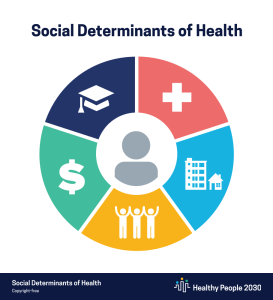1.2 Social Determinants of Health
Social Determinants of Health

There are several different definitions of the Social Determinants of Health (SDOH). Table 1.2.1 includes two definitions. Both definitions are included in this text to provide readers with the broad context of the impact of SDOH within the United States as well as globally.
| “Social determinants of health (SDOH) are the conditions in the environments where people are born, live, learn, work, play, worship, and age that affect a wide range of health, functioning, and quality-of-life outcomes and risks.” (OASH, n.d.) |
| “The social determinants of health (SDH) are the non-medical factors that influence health outcomes. They are the conditions in which people are born, grow, work, live, and age, and the wider set of forces and systems shaping the conditions of daily life. These forces and systems include economic policies and systems, development agendas, social norms, social policies and political systems.” (WHO, 2024) (CDC, 2024) |
Regardless of the definition, the common message is Social Determinants of Health (SDOH) are the non-medical factors that significantly influence health outcomes. These factors encompass the conditions in which people are born, grow, work, live, and age, as well as the broader forces and systems that shape daily life. There is an increased focus on understanding and addressing social determinants of health. By creating environments that promote health and well-being for everyone, we can work toward reducing disparities and improving overall population health.
Examples of social determinants of health
- Safe Housing, Transportation, and Neighborhoods: Access to secure housing, reliable transportation, and safe neighborhoods impacts overall well-being.
- Racism, Discrimination, and Violence: These social factors can profoundly affect health outcomes and quality of life.
- Education, Job Opportunities, and Income: Educational attainment, employment opportunities, and income levels play a crucial role in health.
- Access to Nutritious Foods and Physical Activity Opportunities: Availability of healthy food options and opportunities for physical activity influence health.
- Polluted Air and Water: Environmental factors directly impact health and can lead to health disparities.
Social Determinants of Health contribute to health disparities and inequities. For instance, individuals without access to grocery stores offering healthy foods are at higher risk of conditions like heart disease, diabetes, and obesity. Addressing these determinants requires collaborative efforts across sectors such as education, transportation, and housing to improve environmental conditions and promote health for all. Table 1.2.2 provides resources for developing collaborative partnerships to address the SDOH.
| Partnership Assessment Tool for Health | Includes resources for developing new partnerships. |
| National Association of County and City Health Officials (NACCHO). (2024.). Community Health Assessment | Includes resources for engaging local public health system partners. |
| Supporting Change Agents across Sectors to Improve Health and Equity in Rural Communities | Describes project findings related to health improvement change agents across sectors. |
Strategies for Addressing the Social Determinants of Health
Medbridge (2022) Demonstration of Assessing for Social Determinants of Health [Video] https://www.youtube.com/watch?v=C-xyGRWjDx0
Click here to read next: 1.3 Population Health Assessment
A difference between groups or aggregates. For example, Differences may occur by gender, race or ethnicity, education, income, disability, geographic location and sexual orientation among others.

